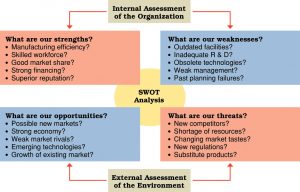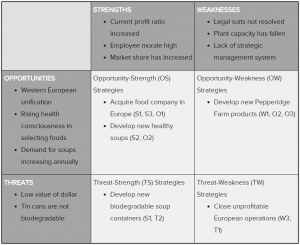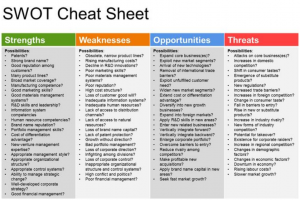Difficulty: Time:
What is a SWOT Analysis ?
Well hello. We were all here once, learning about the SWOT. Its a classic, very much like The Godfather is to movies, as this is to strategy and marketing tools. Here we will describe how to use it, and give you some examples. We won’t go too much in to detail here, because we have another SWOT analysis which we will also discuss for those who want to either impress their professors, colleagues or partners.
So, what is the SWOT. It stands for Strengths, Weaknesses, Opportunities and Threats. And the key point here is that its very important to remember that the strengths and weaknesses are an internal analysis of your company, while opportunities and threats are external assessments. Below you can see a quick example of some things you could ask yourself to include in the SWOT.

What is a SWOT used for?
In brief, it can be used for absolutely anything. If you were really creative you could even do one for a relationship. But, lets stick to business here.
In marketing its integrated into the marketing plan, but it can also be used to generate an overall company strategy. Its designed to scan the internal and external environment which you are competing within, as an important part of the strategic planning process.
Its a great way to match your business capabilities and resources to the industry and market you are operating in. From the SWOT analysis you will be able to generate strategies where you are able to have competitive advantages in, while also understand where you should be defensive. If this doesn’t make much sense, don’t worry. By the end of this article you will have a clear picture of how it works and comes together.
How do you use it in practice?
We recommend you do not start with the SWOT until you have done a situtation analysis, competitors analysis, market analysis (PESTEL), and or Porter’s Five Forces. When you have completed these not only will it be much easier to complete the SWOT, but then you can be sure not to have missed something crucial. The SWOT will take elements from all the before mentioned methods, and integrate them in a way where you will be able to develop a strategy from it.

Strengths: are those specific characteristics which you excel at, and give you an advantage over your competition. They can include resources as well as capabilities which can be beneficial in achieving competitive advantages. Strengths can include some of the following:
- Strong brand equity
- Patents
- Capital
- Strategic partnerships
- Proprietary intellectual property
- Unique Selling Proposition
- Access to lowest-costing resources?
- Loyal customer base
Weaknesses: are characteristics that hinder your business from operating at an efficient or optimum level. These are areas where improvement is necessary in order to continue being competitive. They can include some of the following:
- No patent protections
- Low brand equity
- Lack of capital, or high debt
- High costs
- Bad Reputation
- Lack of a loyal customer base
Opportunities: are factors in the external environment that are favourable to your business. They, like strengths, may provide you with a competitive advantage and open up profit and growth opportunities. We have mentioned some examples here:
- Emerging new technologies
- Depending on your position, either loosening or tightening of regulations
- Trade barriers removed
- Customer needs changing
- Postitive trends
- Unfulfilled needs of consumers
Threats: are also factors in the external environment, but they are unfavourable to your business. They, just like weaknesses, may hinder your competitive advantage and company performance. They can include some of the following:
- Emerging new technologies
- Depending on your position, either loosening or tightening of regulations
- Trade barriers imposed
- Customer needs changing away from your business products
- Negative trends
- Introduction of substitute products
Once you have completed your SWOT analysis. Go back and organize it. We suggest to list them according to importance and maybe keep the top 5 to 7. It really depends on you.
The next step will be to lay each of the elements you have created outside of the boxes and think about how Strengths/Opportunities, Weaknesses/Opportunities, Threats/Strengths, Weaknesses/Threats can be leveraged together to generate strategies for you moving forward.

Tips and Tricks (What to do and dont do)
As mentioned before, by the time you get to doing your SWOT you should already have a fairly good understanding of your own company, your competition, and your market. For the SWOT to provide you with fruitful results, don’t rush to it before doing the others.
Additionally, we have seen many people use it as sort of a summary of their previous analysis. Though, the first step to it can seem so don’t forget that there is another step. Which is the most crucial and of greatest importance, strategy, strategy, strategy. The main reason you do a SWOT analysis is to develop strategies for your business.

Example at a real use case
Insert other examples here….








